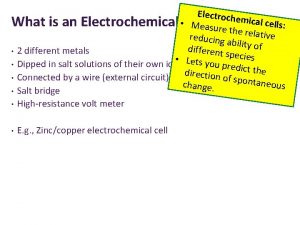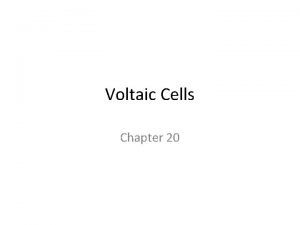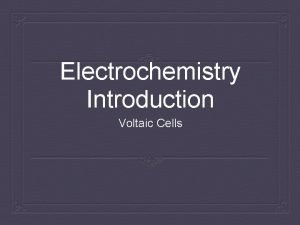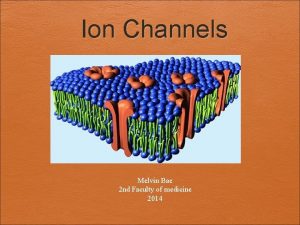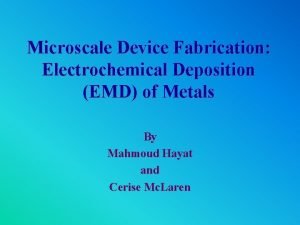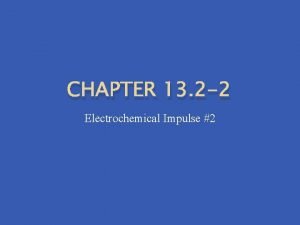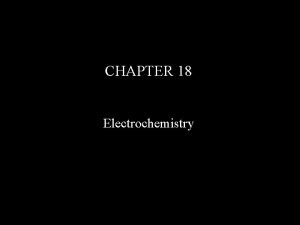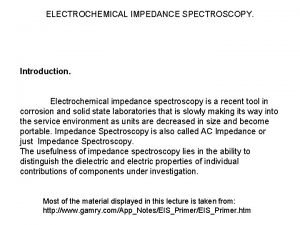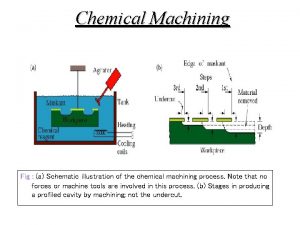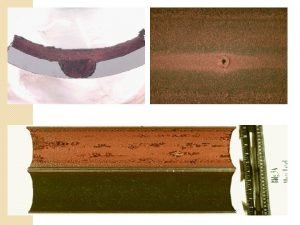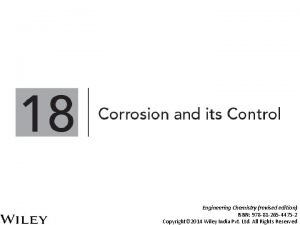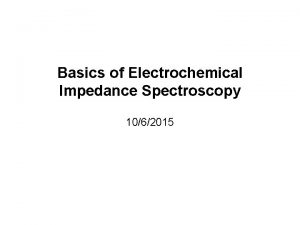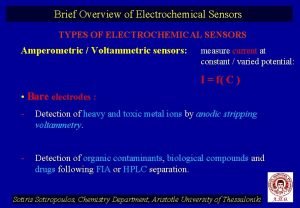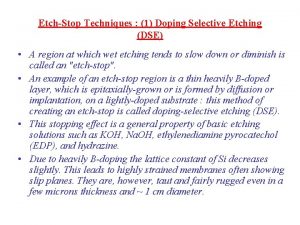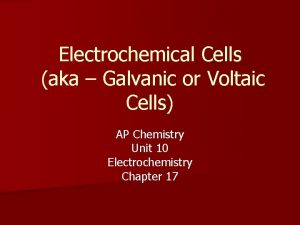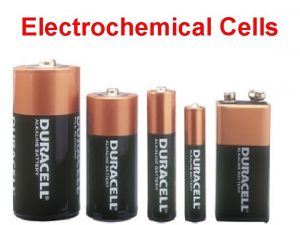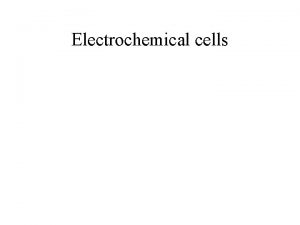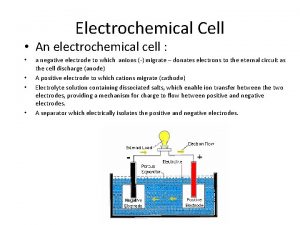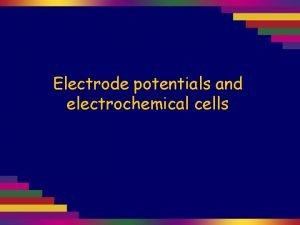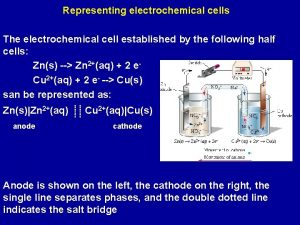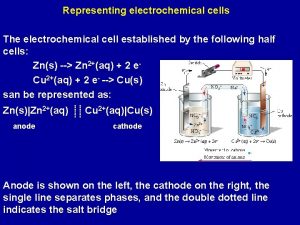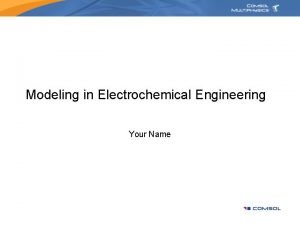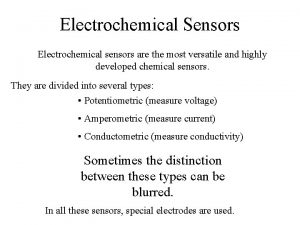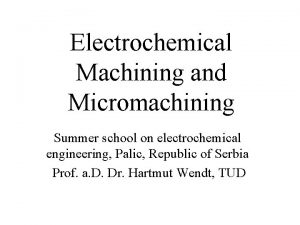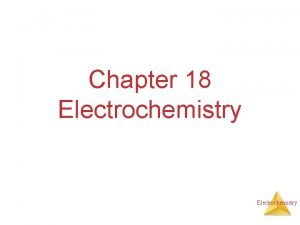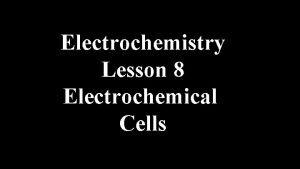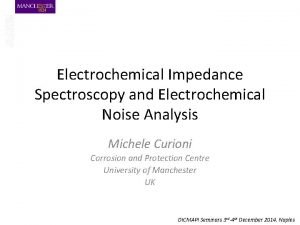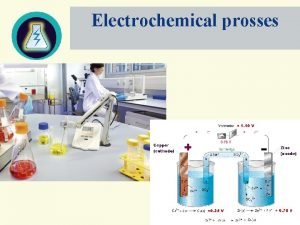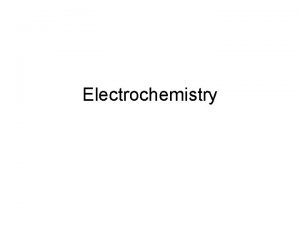Electroch emical ce What is an Electrochemical Cell



















- Slides: 19

Electroch emical ce What is an Electrochemical • Cell? lls: Measure the relati ve reducing ability of different • 2 different metals • Lets yo species • Dipped in salt solutions of their own ions u predict the direction • Connected by a wire (external circuit) of sponta neous change. • Salt bridge • High-resistance volt meter • E. g. , Zinc/copper electrochemical cell

Do Now - Zinc/copper electrochemical cell 1. Write half equations for the reactions 2. Which is an oxidation reaction and which is reduction? 3. What has happened to the SO 42 - ions? 4. Name the reducing agent. 5. Name the oxidising agent. 6. What is the overall equation? Half equations: Zn(s) → Zn 2+(aq) + 2 e. Cu 2+ (aq) + 2 e- → Cu(s) • Oxidation Reduction

A simple zinc half-cell Zn 2+(aq) + 2 e– ↔ Zn(s)

In this electrochemical cell, e- flow in the external circuit from left to right, giving a pd of +1. 103 V The zinc electrode loses e- so the position of Eqm lies to the left. Zn 2+(aq) +2 e- ↔ Zn The copper electrode gains e- so the position of Eqm lies to the right. Cu 2+(aq) +2 e- ↔ Cu

- electrode anode oxidation At this electrode the metal loses electrons and so is oxidised to metal ions. + electrode cathode reduction electron flow REDCAT At this electrode the metal ions gain electrons and so is reduced to metal atoms. Zn These electrons make the electrode negative. Zn 2+ + 2 eoxidation Cu As electrons are used up, this makes the electrode positive. Cu 2+ + 2 e- Cu reduction

Representing Cells • Simple way to represent cells. . . • Standard cell notation or cell diagram for zinc/copper cell. • OIL R O RIG O R Zn(s) I Zn 2+(aq) II Cu 2+(aq) ICu(s) • Single vertical line: Separates 2 phases (s, and aq) • Double vertical line: Salt bridge. • 2 (aq) solutions are next to the salt bridge • 2 single lines at each end • If a half-cell contains a mixture of aq ions, a comma is used to separate them • Fe(s) I Fe 2+(aq), Fe 3+(aq)

OIL RO UNLESS TOLD IN THE QUESTION … Reduction on the RIGHT Lowest on the LEFT RIG OR Ni(s) | Ni 2+(aq) || Sn 4+(aq), Sn 2+(aq) | Pt(s) K(s) | K+(aq) || Mg 2+(aq) | Mg(s)

Example Magnesium and Copper Mg: E°= -2. 37 V Cu: E° = +0. 34 V Which one will carry out oxidation? Which one will carry out reduction? What is the overall emf of the cell? (Clue: E° cell = E°right - E°left)

Calculating emf (Eθcell) Eθcell = EθR - EθL Eθcell = EθReduced - Eθoxidised Zn 2+ + 2 e- ↔ Zn E° = -0. 76 Cu 2+ + 2 e- ↔ Cu E° = +0. 34 UNLESS TOLD IN THE QUESTION … Reduction on the RIGHT Lowest on the LEFT (the most + goes in forward direction) Zn + Cu 2+ → Zn 2+ + Cu Eθ cell = Eθ R - Eθ L = +0. 34 – (-0. 76) = +1. 10 V + answers tells us that the reaction IS feasible

Task • Electrochemistry Workbook Task 7 Q 1 -7

ELECTRODE POTENTIALS – Q 1 Emf = E°right - E°left - 2. 71 = E°right - 0 E°right = - 2. 71 V

ELECTRODE POTENTIALS – Q 2 Emf = E°right - E°left Emf = - 0. 44 - 0. 22 Emf = - 0. 66 V

ELECTRODE POTENTIALS – Q 3 Emf = E°right - Evleft Emf = - 0. 13 - (-0. 76) Emf = + 0. 63 V

ELECTRODE POTENTIALS – Q 4 Emf = E°right - E°left a) Emf = + 0. 15 - (-0. 25) = +0. 40 V b) Emf = + 0. 80 - 0. 54 = +0. 26 V c) Emf = + 1. 07 - 1. 36 = - 0. 29 V

ELECTRODE POTENTIALS – Q 5 Emf = E°right - E°left +1. 02 = +1. 36 - E°left = + 1. 36 - 1. 02 = +0. 34 V

ELECTRODE POTENTIALS – Q 6 Emf = E°right - E°left a) E°right = +2. 00 - 2. 38 = - 0. 38 V Ti 3+(aq) + e- ↔ Ti 2+(aq) b) E°left = -2. 38 - 0. 54 = - 2. 92 V K+(aq) + e- ↔ K(aq) c) E°right = - 3. 19 + 0. 27 = - 2. 92 V Ti 3+(aq) + e- ↔ Ti 2+(aq)

ELECTRODE POTENTIALS – Q 7 a) Cr(s) | Cr 2+(aq) || Zn 2+(aq) | Zn(s) Emf = -0. 76 - (-0. 91) = +0. 15 V b) Cu(s) |Cu 2+(aq)|| Fe 3+(aq), Fe 2+(aq)| Pt(s) Emf = +0. 77 - 0. 34 = +0. 43 V c) Pt(s) | Cl-(aq)| Cl 2(g) || Mn. O 4 -(aq), H+(aq), Mn 2+(aq)| Pt(s) Emf = +1. 51 – 1. 36 = +0. 15 V

Standard Electrode Potential Cell Diagrams • Standard hydrogen electrode is always written on the left-hand side. • Pt(s) I ½ H 2 (g) I H+ (aq) II Zn 2+(aq) I Zn(s) • Pt(s) I ½ H 2 (g) I H+ (aq) II Cu 2+(aq) I Cu(s)

Quick Check 1. a. Explain the functions in an electrochemical cell of a salt bridge and a high-resistance voltmeter. b. Describe the electrochemical cell represented by: Pt(s) I Fe 2+(aq), Fe 3+(aq) II Ag+(aq) I Ag(s) Complete Questions on page 91 of textbook.
 Half cell reaction
Half cell reaction Electroch
Electroch Cathode vs anode equation
Cathode vs anode equation Balance redox
Balance redox Electrochemical gradient
Electrochemical gradient Electrochemical deposition
Electrochemical deposition Electrochemical impulse
Electrochemical impulse Electrochemical series
Electrochemical series Electrochemical impedance spectroscopy
Electrochemical impedance spectroscopy Electrochemical machining advantages and disadvantages
Electrochemical machining advantages and disadvantages Stress corrosion
Stress corrosion Electrochemical gradient
Electrochemical gradient Galvanic corrosion
Galvanic corrosion Electrochemical impedance spectroscopy basics
Electrochemical impedance spectroscopy basics Types of electrochemical sensors
Types of electrochemical sensors Electrochemical impulse
Electrochemical impulse The stage that creates an “electrochemical gradient”. *
The stage that creates an “electrochemical gradient”. * Dse
Dse Giner electrochemical systems
Giner electrochemical systems Electrochemical machining animation
Electrochemical machining animation

